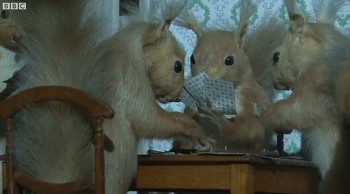museums
Last chance to see: Anthropomorphic Taxidermy at the Museum of Everything
Posted by Higgs Raccoon on Wed 2 Feb 2011 - 07:30 An exhibition of the works of Walter Potter, Victorian taxidermist and collector, is being extended at London's Museum of Everything.
An exhibition of the works of Walter Potter, Victorian taxidermist and collector, is being extended at London's Museum of Everything.
Walter Potter (1835-1918) was a self-taught English taxidermist who created elaborate anthropomorphic tableaux of small mammals and birds. These dioramas, along with various other odd items, were put on display in Potter's museum in Bramber, Sussex.
The Bunny Museum
Posted by ciaran_skye on Fri 16 Jan 2004 - 09:21The Louisville Courier-Journal had an article in it's Features section about The Bunny Museum which has been entered into the Guinness Book of World Records as having the largest collection of rabbit memorabilia in the world.
Museum Chronicles Dogs at Sea
Posted by Cordite on Tue 20 May 2003 - 06:01Connecticut's Mystic Seaport is currently presenting a special exhibit on dogs and their role at sea throughout history.
Titled Sea Dogs: Great Tails of the Sea, it is the museum's newest and - as they say - furriest presentation. During the summer months it will include demonstrations with various dogs showcasing their abilities in and around water, along with dog related art, stories, and activities.
Only a Temporary Extinction?
Posted by Sardonicus on Tue 28 May 2002 - 14:19Since late 1999, the Australian Museum has involved in a project unique in this world- the cloning of an extinct species, namely the Tasmanian Tiger. While no living representative of this species has been witnessed since the death of the last one in captivity in 1936, the museum possesses several preserved pups. While the ones that were preserved in formalin are unusable due to the effect of the preservative on the cell structure, there is a female pup that was preserved in ethanol. She is the linchpin of the cloning project, as this allowed intact DNA strands to persist. While the successful replication of individual Tasmanian Tiger genes, as detailed at http://www.austmus.gov.au/thylacine/newsrelease.htm,
does not mean there will be a living representive of the species any time soon, it does mark something singular. For the first time in human history, there is the indication that we may be able to bring back from the darkness of death and total extinction a unique species that was destroyed solely by our hands.